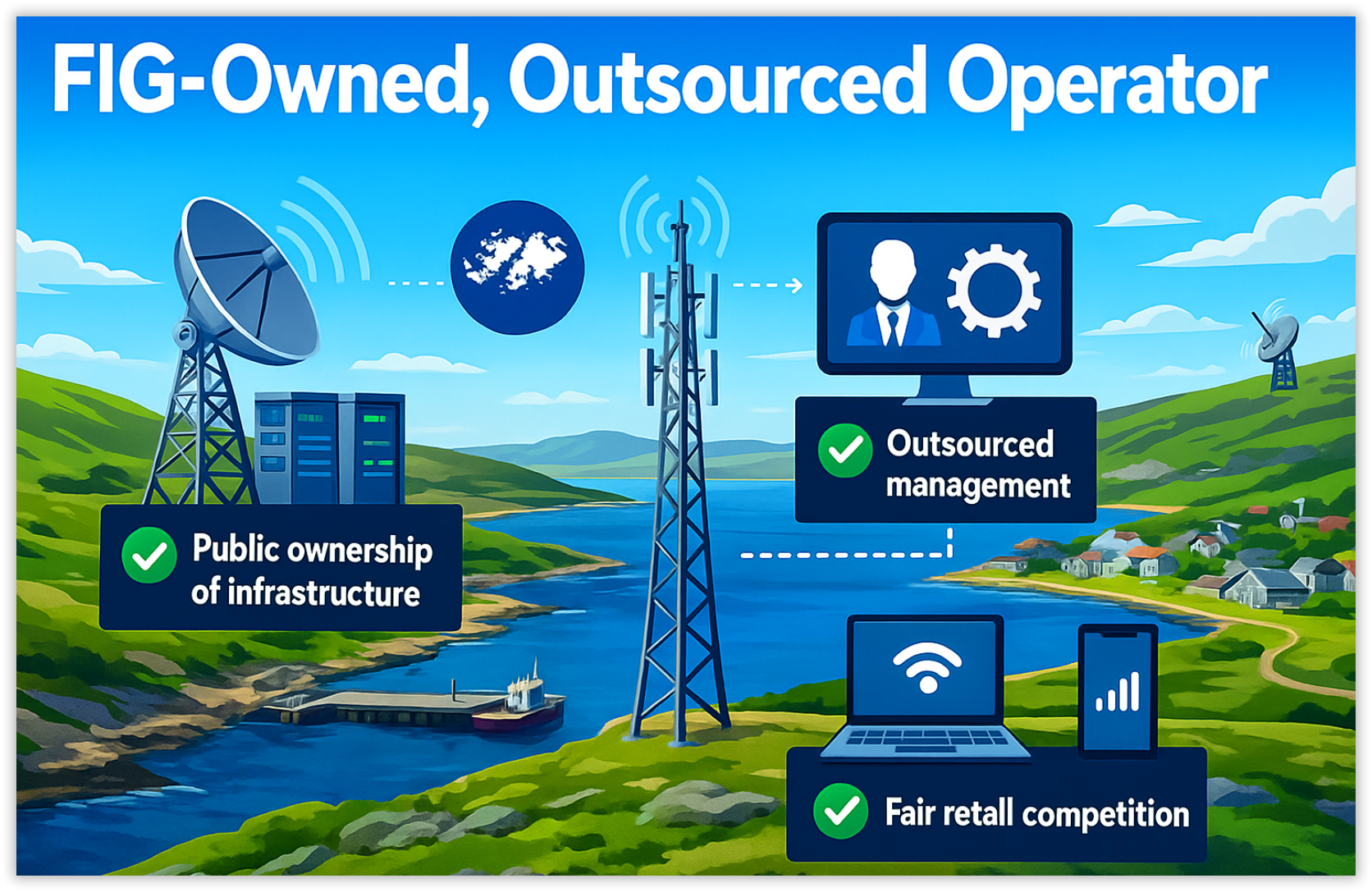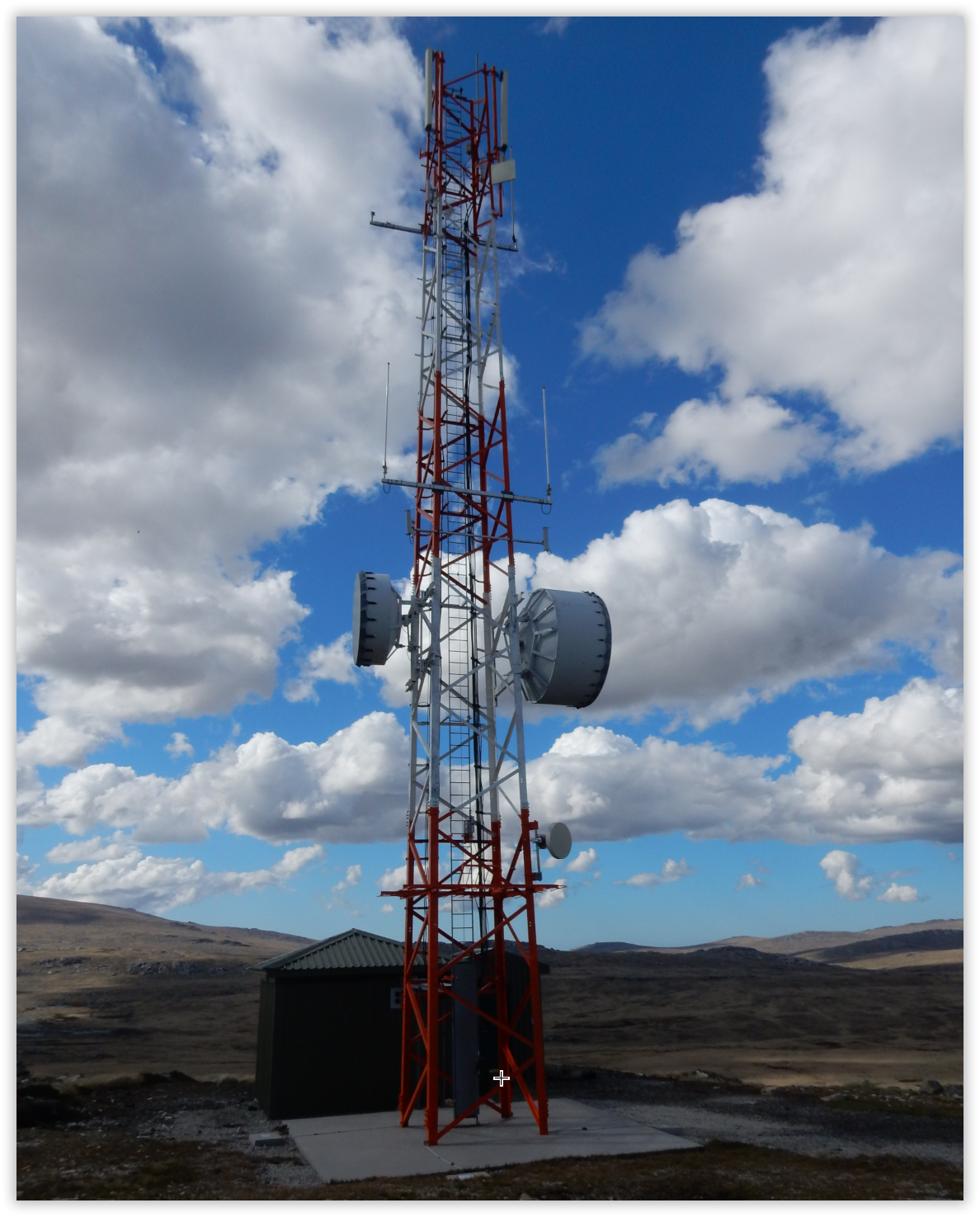
| Caveat: The views expressed in this OpenFalklands post are solely my own. While I do not speak for others, I hope they may resonate with many Falkland Islanders. |
Over the past few weeks, several readers have inquired about the potential implications of the Falkland Islands Government (FIG) adopting a different approach to telecoms management; one that retains public ownership while leveraging external telecoms expertise to enhance service quality. This has often been driven by their poor experience of telecommunications services under a monopoly regime.
After examining several options, the model that seems to fit the Falklands best is the FIG-Owned, Outsourced Operator model as discussed in a previous post – Choosing the Right Public-Private Model for the Falklands beyond 2028. This current post provides a 101-level overview of how such a change could be implemented.

In Simple Terms
Under this Public-Private Venture (PPV) model, FIG would own all the telecoms core terrestrial infrastructure but would use an independent private company to run and maintain it. This would not be classified as an exclusive licence.
That operator could even be one of the same companies offering retail services (like broadband, PSTN or mobile) to customers, but there’d be strict rules to make sure they treat everyone fairly. No favouring their own retail arm, everyone would compete on equal terms.
The Upsides
✅ FIG keeps ownership of a key national asset.
✅ People with the right experience handle the day-to-day running.
✅ Retail competition means more choice and fairer prices for islanders.
The Cautions
⚠️ The contract needs to be tight, and FIG must stay firmly in control. That’s where a “golden share” comes in, giving FIG final say over any major decisions that could affect neutrality or public interest.
Why It Makes Sense
The FIG-Owned, Outsourced Operator model balances public ownership with professional management, safeguarding critical national infrastructure while improving service quality. Separating ownership from retail operations enables fair competition, better choices, and competitive pricing for islanders. The phased approach manages financial risk, supports strategic investment, and builds long-term institutional capability within FIG. Future-proofing the network with modern technology ensures resilience, connectivity, and economic growth. This model positions the Falklands for a sustainable, secure, and efficiently managed telecoms system that serves the public interest for decades.

How To Get There
It wouldn’t happen overnight, and not until after the end of the existing exclusive licence in December 2027. Here’s how the process could look step by step.
1️⃣ Setting the Rules
First, FIG and the MLAs would need to formally agree on this direction and determine its priority relative to other significant projects in the islands, such as the new port. That means new legislation to replace the current monopoly system and to define clearly:
- Public ownership of the network,
- Rules for competition,
- How prices and service quality will be regulated,
- How FIG’s “golden share” protects the public interest.
- And agree on the financing aspects.
That legal groundwork makes sure the system is transparent, fair, and built to last.

2️⃣ Taking Control of the Network
FIG would need to consider taking ownership of the existing telecoms infrastructure post the lapse of the existing exclusive telecommunications licence in December 2027. That starts with a full audit of Sure SA’s existing telecommunications assets, followed by an independent valuation to determine their value.
It is essential to recognise that a significant portion of the PSTN, Camp LTE, Stanley ADSL and broadband terrestrial telecommunications infrastructure is technologically dated and, in many cases, already fully financially depreciated. The primary exception – and maybe the 2nd earth station dish – lies in the recent investments in OneWeb’s low Earth orbit (LEO) equipment; however, its overall value remains commercially limited due to its relatively modest utilisation thus far in the face of widespread Starlink usage.
After that, FIG can negotiate a reasonable deal with Sure SA to buy or transfer the assets and staff. Spectrum licences (the rights to use radio frequencies) and Intelsat satellite capacity contracts would also move to FIG, which would then lease them out to the chosen operator(s).


3️⃣ Planning the Finances
FIG would need to plan how to fund the acquisition, transition, and necessary upgrades to Stanley and Camp infrastructure, whether that’s through reserves, borrowing, or phased payments.
A clear wholesale pricing system would make sure retail companies pay their fair share to use the network, while independent audits keep spending under control.
The goal is straightforward: to improve telecoms without straining public finances excessively.
4️⃣ Setting Up Oversight
Once FIG owns the network, it’ll need strong governance and regulation. That might mean upgrading the current regulatory regime.
The Communications Regulator’s continuing role would be to:
- Set fair wholesale prices,
- Licence ISPs and mobile providers,
- Enforce service quality, and
- Protect consumers.
A new holding company could manage the assets, with a board including government, subject experts, and local representatives. The golden share keeps ultimate control with the community through FIG.
5️⃣Identifying the Operator
Since FIG wouldn’t be running the telecoms service directly or managing the core infrastructure, the next step would be to find experienced operators through an open international tender. This work started in 2025 with FIG’s contract with Cambridge Management Consulting CMC.
That contract would set out exactly what’s expected, uptime, coverage, service standards, and upgrades, with penalties if those aren’t met.
This brings in global telecoms expertise while keeping the network under local ownership and control.

6️⃣ Opening Up the Market
Once the wholesale network is in place, retail competition can begin if that is deemed sensible. FIG could license a broadband ISP to provide an Internet access service in addition to Starlink and maybe OneWeb, and another to operate the 4G mobile service, encouraging both local entrepreneurs and new entrants from abroad to take part.
A smooth transition plan would move customers from the current monopoly into a competitive environment, without interruptions.

7️⃣ Building for the Long Term
Telecoms in the Falklands must operate effectively in all conditions, including storms, satellite outages, and everything in between. FIG will need to build resilience and future-proofing into the system:
- Reliable and affordable backhaul (using satellites now, possibly an undersea cable in a few years’ time),
- Acceptable coverage, even in Camp – my last post talks about this depth –
Beyond the Towers: Starlink and the Future of Falklands Camp Connectivity
And a roadmap for new technology, such as fibr,e in Stanley –
Stanley’s Broadband Crossroads: From Copper Legacy to Fibre Future

8️⃣ Keeping Everyone in the Loop
Finally, none of this will work without public understanding and support. FIG will need to communicate clearly about what’s changing, why, and how it affects people and businesses – before any final decisions are made.
That means consultations, Q&As, and community updates so everyone has a say and confidence that we’re not just swapping one monopoly for another.
Building FIG’s Capability to Deliver
Because FIG currently lacks the staff and technical expertise to manage such a transition, it will need to establish a structured programme to ensure its effective delivery. In the short term, this should include engaging strong specialist advisory support to guide and accelerate the implementation of the steps outlined above.
However, FIG cannot depend solely on external consultants and their expertise. It is essential to develop internal capacity and institutional knowledge so that local teams can manage, regulate, and adapt the system sustainably over the long term. Failing to do so risks repeating past mistakes, as the maxim holds true: those who ignore history are doomed to repeat it.
In essence, FIG’s role will be to set the strategic direction, own the core infrastructure, and maintain strong oversight, balancing the use of external expertise with the deliberate growth of local capability.


The Financing Challenge
A key consideration is whether FIG can realistically support a major additional funding programme for the proposed telecoms project as presented, given the current financial outlook. The 16th September FIG Funds & Borrowing presentation highlights a 5-year forecasted deficit of £304 million, underscoring the significant financial pressures FIG faces.
However, while the proposed telecoms model will compete with other high-priority capital initiatives such as the new port development, housing and infrastructure, and road improvements, its societal and economic impact is unique. Telecommunications underpins virtually every aspect of life in the Falkland Islands, from business and government operations to education, healthcare, and daily communications. Its strategic importance is therefore comparable to, or arguably exceeds, that of other seemingly essential drains on finance.
Investing appropriately in this project is not merely a matter of infrastructure spending; it is an investment in the long-term resilience, connectivity, and economic growth of the Falklands. Consequently, securing adequate funding for telecoms and agreeing on an appropriate structural model should be considered a top-tier priority. This issue will undoubtedly feature prominently for new MLAs following the December 2025 elections, as it should.

Building and Keeping Local Skills
It is essential to recognise that the primary asset of any telecommunications operator lies not merely in its infrastructure, but in the experience and expertise of its local operations staff. Retaining skilled local and expatriate personnel will be critical to maintaining service continuity and safeguarding institutional knowledge during any transition period. FIG should therefore consider offering transitional roles or secondments to ensure this expertise is preserved throughout the handover process.
At the same time, any outsourcing agreement must include a skills transfer programme, requiring the selected operator to train FIG staff and local technicians in areas such as network management and regulatory compliance. Over time, this approach will reduce dependence on external consultants and support the development of a resilient telecommunications system managed sustainably from within the Islands.

The Bottom Line
A FIG-Owned, Outsourced Operator model could give the Falklands the best of both worlds:
✅ Public control of essential national infrastructure,
✅ Professional management and modernisation by experts with the right experience, and
✅ A fair, competitive market that delivers better service and value for islanders.
It’s not a quick fix, or low-cost one, nor should it be. Building a telecoms system that’s resilient, future-proof, and genuinely serves the public interest takes time, planning, and transparency. But if FIG takes a measured, consultative approach – as I’m sure it will – and stays firm on the principles of fairness, accountability, and open competition, this model could mark a real turning point in how the Falklands connect to the world.
Done right, it ensures that the islands remain not just connected, but confidently connected with a system designed by and for Falkland Islanders, balancing local control with global expertise. It’s a sustainable path forward, one that secures digital sovereignty while unlocking new opportunities for growth, innovation, and community in the years ahead.

Relevant OpenFalklands posts
Governance models
✅ Choosing the Right Public-Private Model for the Falklands beyond 2028
✅ Laying the Foundations: Community-Owned Telecoms for the Falklands
Technical issues
✅ Stanley’s Broadband Crossroads: From Copper Legacy to Fibre Future
✅ Beyond the Towers: Starlink and the Future of Falklands Camp Connectivity

Chris Gare, OpenFalklands, October 2025, copyright OpenFalklands
